|
Accomplishing the goals of riding a Training Level test is
the foundation of dressage. It is the level where the rider must master the horse’s three natural gaits and maintain
the horse in a relaxed, rhythmic and round frame. Sounds easy! But, harnessing the horse’s three natural gaits to display
in a soft frame or contact where the horse’s hind end travels through the rider’s seat resulting in the horse
giving at the poll onto a soft and receiving hand is not that easy. However, once a rider does master Training Level and continues
on the journey of dressage, or, gymnastic training with the horse, the challenges lessen as the foundation has been set. Below
are photos of a home schooled horse performing at Training Level. By sharing
these photos we are going to experience a
Training Level Test (through the eyes of the camera) and discuss what is going on, why, and maybe a little bit of how.
In the warm Up Arena (photos 1,2 & 3)

|
| Photo 1. |
The warmup arena is often crowded and a rider has to stay
focused with the horse and avoid being distracted. Just the experience of warming up in a crowded arena is a great way to
start because it causes the rider to focus yet maintain peripheral vision (soft eyes) and that is what is needed to ride the
test. Our junior rider has warmed up and her attention is now on the other arena waiting for her number to be called.

|
| Photo 2. |
Enter at A, at X Halt and Salute
The bell has rung and the rider (a junior rider with three
years of experience in the saddle) has 45 seconds to get to X. That thought alone would be enough to get anyone’s stomach
in a turmoil. Sounds like a short amount of

|
| Photo 3. |
time, but if you breathe deep, it is almost a minute! Okay,
but just before going in, we break her concentrated spell acquired through warm up and do a few last minute touches: wipe
the boots, tuck in spur straps, check that all keepers are secure and ask, “Do you know your test and which direction
to turn at C?”
Our rider is outside the arena and she is getting ready to
trot down the center line. She needs to bring her left hand up so she has a straight line elbow to bit, however her horse
is soft in the bridle, relaxed and attentive. They are ready.

|
| Photo 4. |
Shortening the reins, she leans a little too forward
in anticipation, nevertheless, our off-the-track thoroughbred prepares for his grand entry. Coming down center line is the
first and last impression the judge gets of you and your horse, so try to make it impressive. (photo 5).
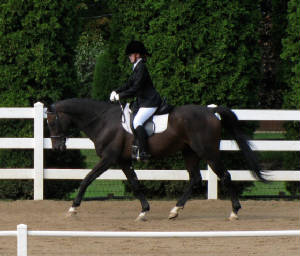
|
| Photo 5. |
Halt at X
Her halt at X is straight and the horse has stayed soft
on the bit and is not against the rider’s hands. (photo 6) Ideally the horse should be square in the back, but at this
level it does not matter too much and the judge can’t see that anyway. Straight, on the center line with a smooth transition
from trot to walk to halt with a submissive horse is enough of a challenge for now.

|
| Photo 6. |
The rider has leaned forward to salute. Sometimes this can
be a problem, as you can see leaning forward caused her leg to move back. She is lucky her horse did not walk off when she
did this. She should practice saluting and not leaning forward, her seat /position should not be jeopardized to salute. Also,
taking the hand off the rein to salute while the horse stays soft and on the aids is always a big plus in dressage, not to
mention taking the rein back after the salute. Practicing the salute before you go to the show is always a good idea! Many
horses interpret taking the reins back as a signal to walk on. Nope, the signal to walk is asking the horse to move off the
leg not taking up contact. Perfect practice makes perfect.
After the halt, your horse is to transition from a walk into
a trot where it stays straight onthe center line till it gets about a horse length away from C. The horse is not to turn too
early, ‘fall in’ off the center line or go wide to the outside of center line and then turn. Practicing riding
the center line before the show is also a good idea. It is challenging riding a horse off a wall with nothing to guide
it and perform fluid transitions while keeping its long body straight. Going from a trot on the quarter line or centerline
on into a walk, and then back into a trot while keeping the horse straight, is a great exercise to learn how to do great centerlines.
When you can go trot / walk and walk/ trot while keeping your horse straight and soft on the bit before during and after transitions
then, add the straight halt. Once this is perfected then add the salute. Training your horse by practicing pieces of the tests
and then learning how to string them all together is a great method for success.
The Reader
Having a reader for your tests is a great advantage. It
helps to take the edge off of knowing where you are going next. With a reader you can completely focus on what you are doing
with your horse. Remember, the judge is always evaluating each moment and each movement of the horse’s relaxation, rhythm,
roundness and accurancy throughout the whole test. The rider, of course, is the pilot who makes it all happen. However, a
rider needs to know the tests too. All tests usually mirror one another, meaning if you do a circle left at E, then when you
change direction and circle to the right it will be at E’s mirror opposite which is B. Knowing this helps a rider to
remember the fluidity of the tests.
At A Turn Right or Left
Which way you turn at A is not an issue in dressage, the
tests will be your directive. The issue is how well you
rode the corner from the center line. Did your horse travel up to C before turning, or did it freak at the judge? And/or did
your horse get into the corner of the turn, or cut the corner? And/or did your horse over or under shoot center line? Once
again sounds simple till you get there.
Riding into the corners teaches the horse to bend and
the rider to use the aids. Good use of the arena, such as using the corners, is required to ride an accurate test. Corners
are good for half halts, setting the horse up for center line, changes of rein across the diagonal and/or canter departs...
Use the corners, for as hard as they may seem to get into they are your friend for gymnastic training and performing awesome
dressage tests.
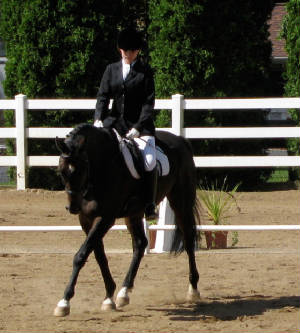
|
| Photo 8. |
The Twenty Meter Circle
In the next two photos (8 & 9) our horse has ridden through the corner and is on a circle at E or B, hard
to tell exactly where she started! Her horse’s body is nicely ‘positioned’ in the direction it is traveling,
which is tracking left or counter clock wise. This rider is letting the horse’s hind end and back travel through her
seat where she directs the energy and size of the circle with her aids. Her outside rein is keeping the horse in balance,
so he is not ‘falling in,’ or making the circle too small. She is sitting nicely in the middle of the horse’s
back and is not leaning to the inside. Everything about them looks harmonious.
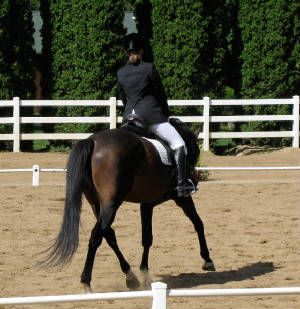
|
| Photo 9. |
This horse is soft, he is not tense or rushing, he is relaxed,
rhythmic and calm. Also, you can see how the rider’s shoulder is slightly back or turning in the direction she and her
horse are traveling. A rider’s shoulders should be in alignment with the horse’s shoulder. Both horse and rider
are positioned left to ride a very nice twenty meter circle. Her inside leg is at the girth bending the horse at the rib cage
and her outside leg is back keeping the haunches from ‘falling out’ and her outside rein is maintaining the balance
and her inside rein is slightly positioning the horse’s neck left. Sounds complicated, till you just do it enough that
it becomes second nature.
Change of Rein Across the Diagonal
Once a rider performs that first perfect circle, then
she makes a change of direction across the diagonal to display the horse's gaits, balance, rhythm and suppleness in the other
direction. Just because a horse goes well in one direction does not necessarily mean it performs as well going the other way.
Basically, for the judge, the rider is showing how well she trained the horse to go ‘both ways.’ Dressage horses
must be ambidextrous, as well as the person training the horse. One sidedness will not benefit either horse or rider.

|
| Photo 10. |
Okay, to get to the other side, the change of rein across
the diagonal too is judged and scored. One does not just meander across the arena on a diagonal line, but ride the horse forward
and straight and then ride into and out of the corners bending the horse through the corner. Going across the diagonal can
be as challenging as the center line. Often a horse will fall either in or out on the diagonal line. In photo 10 our rider
is preparing to come across the diagonal. You can see her concentrating as she has her head up and is looking for the opposing
letter on the other side. If she lands with her shoulder at the letter she will have enough time to get into the corner to
prepare for the next movement.
The Training Level tests usually have either
a transition to walk or a canter depart after the diagonal line. By riding into the corners of the arena, have we emphasized
this enough, the bending not only helps to maintain suppleness for the horse but it preps the horse for the next movement.
If the movement is for a walk, the corner will help to half halt the horse to slow it down, if it is for a canter depart the
corner helps to gather the horse so it coils uphill into a canter.
The Free Walk
Because we don’t want to tire our horses out, all
tests require a walk break in between the trot and canter work. Thus the free walk is either displayed across the diagonal
line or on what is called a ‘broken diagonal line.’
That is two short diagonal lines that meet at X. Please refer to a dressage test, where some of the movements
are illustrated
on the back cover. In photo 11, our rider is walking through a corner preparing to come across the diagonal. She is once again
looking up scouting her next move, good job! Even though her horse should be a little more up in the bridle, they still make
a very harmonious pair. The horse is bending nicely and has obviously been very obedient to her soft commands.
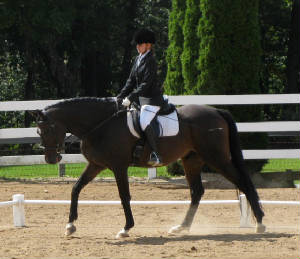
|
| Photo 11. |
Riding through a corner requires quite a bit of finesse, not
that any part of a Training Level test does not, but you can see in photo 11, that she has gotten her horse into the corner
by pushing his body and bending into the corner, keeping him on the outside rein. She has not pulled him into the corner.
Once a rider lands on the diagonal line, after riding
out of the corner in balance, she lets the horse stretch out, or chew the reins out of the hands while walking. Remember do
not allow the horse to stretch in the corner, wait till you get him on the diagonal line.
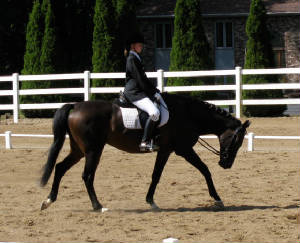
|
| Photo 12 |
Many horses do not stretch, but those that do are rewarded
because
stretching in a dressage test is always double points. Our horse, in photo 12, is stretching real nice, but his
nose is a little behind the vertical. The rider needs to let his nose out a little more. Also, in this photo the horse is
under tracking. That means his hind end needs to step more under his body. When a horse is tracking up, the length of stride
from the two front legs will match the length of stride of the two hind legs.
It is obvious, in photo 12, that the hind end is not stepping under enough. More push from behind would help to get the nose
more forward, but then the rider might risk the horse jigging, or breaking to a trot, which would blow this movement
for her. There is a fine balancing act between horse and rider when riding tests and all options have to be mentally calculated
during the process of riding the test. Certainly this rider is likely thinking, “Do I ask for more walk, or just accept
the walk I have?"
The Canter Depart
After the trot has been displayed for the judge, and the free walk gave the horse a break and a chance to stretch, the
canter is now ridden. Did we mention before, how the corners can set the horse up
for the canter depart? In Training Level
all canter departs are performed either in the corner or just before or after the corner, for that reason mentioned above,
whereas in First Level, the canter is asked for on straight lines.
In photo 13, our rider has leaned forward to ask her horse
to canter, and her toe is out! This is typical for a green rider. Eventually, she will learn to lean back to get the canter
departs, but for now it is okay. Besides, who is going to argue with a horse that looks so beautiful and an elegant junior
rider? Also, it must be mentioned that the horse’s nose is again behind the vertical. But, regardless, he is stepping
up and through the rider and has a nice frame. Need we start to debate whether the horse is either in front of the rider’s
leg, yet behind the bit, or behind the leg and behind the bit? The bottom line is, this horse is connected from back to front,
he is in front of the rider’s leg, but behind the vertical. As this rider starts to ride more uphill herself and not
lean forward, the horse will follow suit and come more up at the poll. First Level here we come.
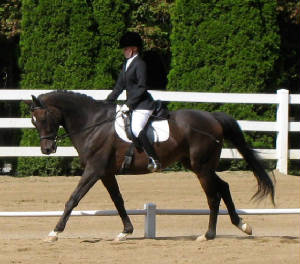
|
| Photo 13. |
The Canter Circle
When we talk about riding a Training Level test, it seems so easy, however putting together all the varying parts
of the test, let alone maneuvering the horse ‘just so,’ gets to become an obsession. Dressage training is definitely
for persons with OCD. The Training Level test is very similar to the Walk Trot test accept for Training Level, the canter
is required. As we have already discussed the canter depart, now with the canter
‘in hand’ we move onto the canter on a twenty meter circle.
Tracking left we have two photos (14 & 15) of our
rider doing a fine job. Her horse is submissive and he is balanced on the outside rein, not to mention he got the correct
lead! Because she has him in balance he can canter uphill and come more under and up. Lets face it, this is still Training
Level so there is a lot of training to accomplish, but for a three year rider and a thoroughbred off the track, these two
are on a path toward success.

|
| Photo 14. |
One reoccurring theme that does appear in all photos, is that
the horse needs to be more up at the poll, and the rider needs to sit more back and, she needs to lift her left hand that
seems to keep slipping below the withers disrupting a good
elbow to bit connection. Things to work on, but if they had nothing to work on, well then maybe they would not be showing
Training Level.
In photo 15, of her tracking right at the canter, showing the judge that she can train her horse to be as athletic
in both directions, she looks just as good. The horse is nicely balanced on the outside rein; even though it is below the
wither, he is submissive and the rider is sitting nicely balanced, meaning, she is not leaning either in or out but sits equally
on both seat bones.
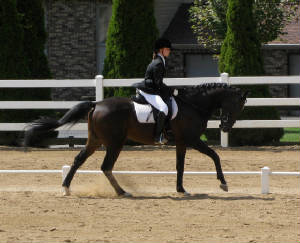
|
| Photo 15. |
The “Stretchy Circle”
This is the best movement of the Training Level test.
Most riders have a hard time allowing the horse to stretch, and no doubt because it is challenging. The test allots you one
twenty meter circle to get the horse stretching and then back up again into the ‘working frame.’ Of course, to
do a correct “stretchy circle” the horse is not suppose to come off the aids in the first place. “The horse
is still in a frame just with a longer rein.” However, to get the horse to stretch the rider has to allow the horse
to lower its head and neck by giving the rein as a result of opening the fingers. In photo 16, our rider is coming out of the corner and is starting to giving the reins to let
her horse stretch. And, he is loving every minute of it.
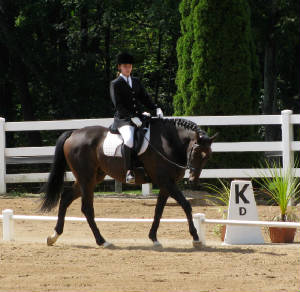
|
| Photo 16. |
A good stretch will allow the horse to lower the head and
neck without the horse pulling the reins out of the rider’s hands, and correct stretching will not put the horse on
the forehand. The correct training of developing the horse’s ring of muscles, establishes the ability for the horse
to carry from the hind end in order to support itself and the rider. Stretching is also a wonderful way to see if a horse
can go in self carriage. Because a horse that can stretch ‘down and out’ then come back up while maintaining balance
and rhythm is a beautiful training moment to behold. And, a rider who can allow the horse to stretch and not be fearful of
not being able to get the horse ‘back together’ and in a frame is a rider who is mastering the basics of truly
classical dressage!
Back to our test. As the rider allows the reins to slip through her hands, as in chewing the reins out of her hands, her horse does not do a nose dive, but remains tracking up,
and carrying himself as he stretches down. But, before you
know it the rider is approaching C, and, as the test states,“before C, shorten the reins,” and proceed working
trot.
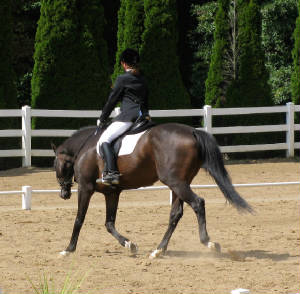
|
| Photo 17. |
Down Center Line, X Halt and Salute
- wipe your forehead - leave the arena
at a free walk on a
loose rein...
Well, this has been quite a journey, about seven long
minutes to be exact! From the first entry at A, to two twenty meter circles at a trot, then a free walk, and a few changes
of rein across the diagonal on into a canter... For the final judgment our rider again descends or ascends down the center
line for a final halt and salute. This better be good, because
this is the judges final impression. Did we mention riding into
the corner to set your horse up for the center line?
Hmm, in photo 18 our rider is starting to relax, as she knows
this is her final moment and she itches her nose coming down center line. Perhaps this is a way to bewitch the horse into
a perfect halt? Needless to say, even one handed, our rider’s horse is straight, relaxed and submissive - he obviously
knows his task at hand. ( Oh, by the way, nice braids.)

|
| Photo 18. |
And, here it is - the final halt, photo 20. Nearly perfect.
Boy, you have to love this pair. Now, the rider leaves the arena on a loose rein. But, before she turns to walk out of the
arena, and this time avoiding the corner, she tries to catch the eye of the judge to see if there are any verbal comments.
If you are lucky, the judge will comment on your ride.
If not, and if you feel inclined, say a polite thank you and humbly walk out of the arena knowing those seven minutes of a
dressage Training Level test displayed the perfect practicing that you have put into schooling your horse.
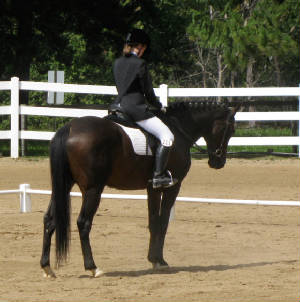
|
| Photo 20. |
The end.
Oh! Wait,
the results......
PS: Every Performance Grand

|
| Horse and Rider's Rewards for a Job Well Done! |
|



